基础英语写作第四章 标点符号
- 格式:ppt
- 大小:568.00 KB
- 文档页数:39
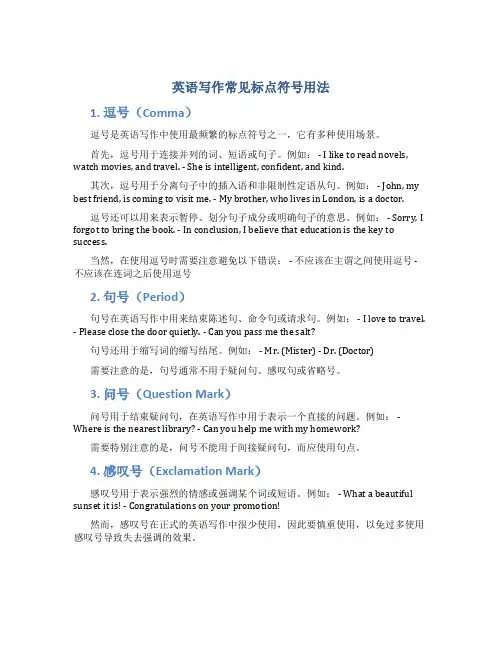
英语写作常见标点符号用法1. 逗号(Comma)逗号是英语写作中使用最频繁的标点符号之一,它有多种使用场景。
首先,逗号用于连接并列的词、短语或句子。
例如: - I like to read novels, watch movies, and travel. - She is intelligent, confident, and kind.其次,逗号用于分离句子中的插入语和非限制性定语从句。
例如: - John, my best friend, is coming to visit me. - My brother, who lives in London, is a doctor.逗号还可以用来表示暂停、划分句子成分或明确句子的意思。
例如: - Sorry, I forgot to bring the book. - In conclusion, I believe that education is the key to success.当然,在使用逗号时需要注意避免以下错误: - 不应该在主谓之间使用逗号 - 不应该在连词之后使用逗号2. 句号(Period)句号在英语写作中用来结束陈述句、命令句或请求句。
例如: - I love to travel. - Please close the door quietly. - Can you pass me the salt?句号还用于缩写词的缩写结尾。
例如: - Mr. (Mister) - Dr. (Doctor)需要注意的是,句号通常不用于疑问句、感叹句或省略号。
3. 问号(Question Mark)问号用于结束疑问句,在英语写作中用于表示一个直接的问题。
例如: - Where is the nearest library? - Can you help me with my homework?需要特别注意的是,问号不能用于间接疑问句,而应使用句点。
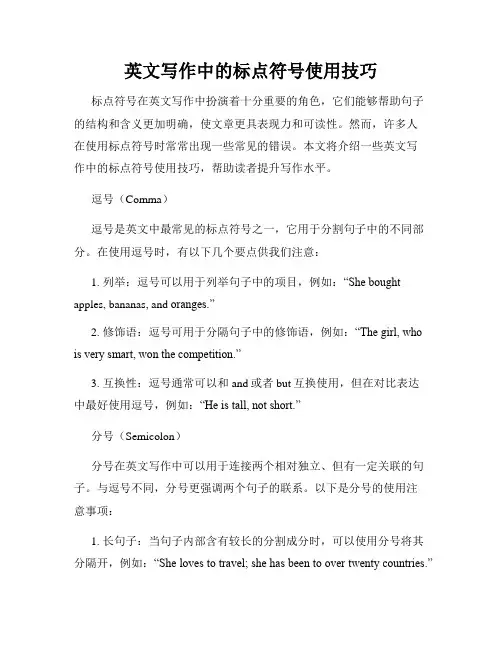
英文写作中的标点符号使用技巧标点符号在英文写作中扮演着十分重要的角色,它们能够帮助句子的结构和含义更加明确,使文章更具表现力和可读性。
然而,许多人在使用标点符号时常常出现一些常见的错误。
本文将介绍一些英文写作中的标点符号使用技巧,帮助读者提升写作水平。
逗号(Comma)逗号是英文中最常见的标点符号之一,它用于分割句子中的不同部分。
在使用逗号时,有以下几个要点供我们注意:1. 列举:逗号可以用于列举句子中的项目,例如:“She bought apples, bananas, and oranges.”2. 修饰语:逗号可用于分隔句子中的修饰语,例如:“The girl, who is very smart, won the competition.”3. 互换性:逗号通常可以和and或者but互换使用,但在对比表达中最好使用逗号,例如:“He is tall, not short.”分号(Semicolon)分号在英文写作中可以用于连接两个相对独立、但有一定关联的句子。
与逗号不同,分号更强调两个句子的联系。
以下是分号的使用注意事项:1. 长句子:当句子内部含有较长的分割成分时,可以使用分号将其分隔开,例如:“She loves to travel; she has been to over twenty countries.”2. 顺接关系:如果两个句子之间存在顺接关系,可以使用分号表示,例如:“He was tired; however, he continued working.”连字符(Hyphen)连字符在英文写作中有多种用途,我们可以通过以下几个方面了解其使用技巧:1. 连接单词:连字符可以用于连接两个或多个有关联的单词,例如:“state-of-the-ar t technology”。
2. 描述范围:在表示范围时,可以使用连字符,例如:“pages 35-39”。
3. 合成词:在形成合成词时,连字符可以连接两个单词,例如:“well-known”, “life-changing”。
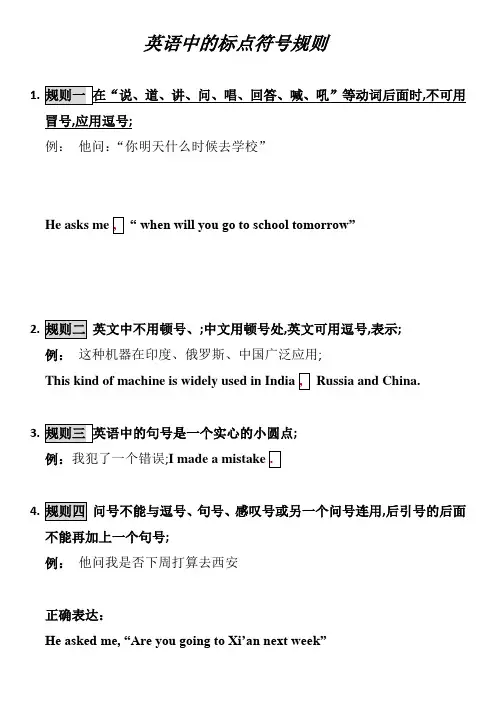
英语中的标点符号规则1.冒号,应用逗号;例:他问:“你明天什么时候去学校”“ when will you go to school tomorrow”2.英文中不用顿号、;中文用顿号处,英文可用逗号,表示;例:这种机器在印度、俄罗斯、中国广泛应用;Russia and China.3.;例:我犯了一个错误;4.问号不能与逗号、句号、感叹号或另一个问号连用,后引号的后面不能再加上一个句号;例:他问我是否下周打算去西安正确表达:He asked me, “Are you going to Xi’an next week”错误表达:5.,冒号和分号必须置于引号之外;问号和感叹号,如果与引语有关,放在引号之内;如与整个句子有关,则放在引号之外;She said, “I want to see a movie.”“The movie,” she said, “ is interesting.”I am reading “A Tale of Two Cities”. 我正在看双城记;英文中省略号是三个点,居下;中文中省略号是六个点,居中;例:他想啊,想啊,想啊……He thought, and thought, and thought…6.,或放在一个主句和从句之间,也不能引起多个并列的结构;另外,分号后面的分句前面不能再使用并列连词and, but, or, for等;附:分号的用法1)用于没有连接词连接而句子的关系又比较密切的并列句之间;太阳现在开始落下;影子变得很长;The sun was setting now; the shadows were long.2)用以代替逗号,分隔句中已含有逗号的部分;There are two facts to consider: first, the weather; second, the expense.两件事需要考虑:第一件,天气;第二件,花销;。
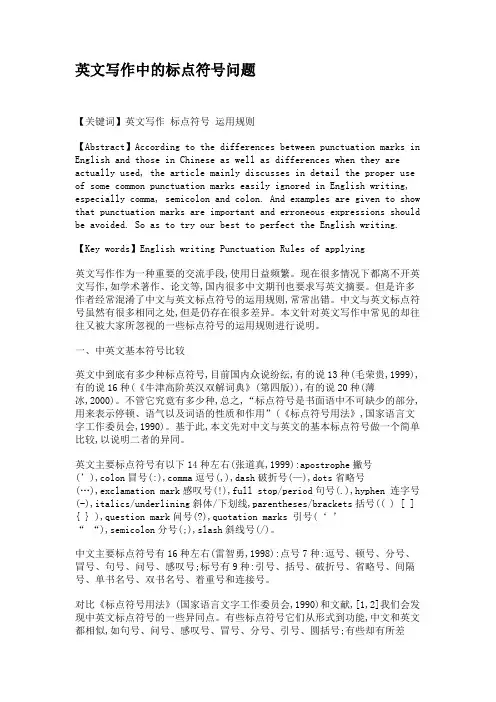
英文写作中的标点符号问题【关键词】英文写作标点符号运用规则【Abstract】According to the differences between punctuation marks in English and those in Chinese as well as differences when they are actually used, the article mainly discusses in detail the proper use of some common punctuation marks easily ignored in English writing, especially comma, semicolon and colon. And examples are given to show that punctuation marks are important and erroneous expressions should be avoided. So as to try our best to perfect the English writing.【Key words】English writing Punctuation Rules of applying英文写作作为一种重要的交流手段,使用日益频繁。
现在很多情况下都离不开英文写作,如学术著作、论文等,国内很多中文期刊也要求写英文摘要。
但是许多作者经常混淆了中文与英文标点符号的运用规则,常常出错。
中文与英文标点符号虽然有很多相同之处,但是仍存在很多差异。
本文针对英文写作中常见的却往往又被大家所忽视的一些标点符号的运用规则进行说明。
一、中英文基本符号比较英文中到底有多少种标点符号,目前国内众说纷纭,有的说13种(毛荣贵,1999),有的说16种(《牛津高阶英汉双解词典》(第四版)),有的说20种(薄冰,2000)。
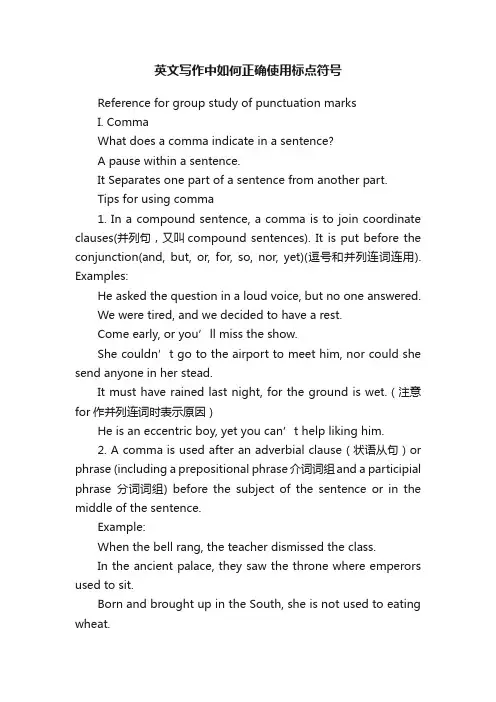
英文写作中如何正确使用标点符号Reference for group study of punctuation marksI. CommaWhat does a comma indicate in a sentence?A pause within a sentence.It Separates one part of a sentence from another part.Tips for using comma1. In a compound sentence, a comma is to join coordinate clauses(并列句,又叫compound sentences). It is put before the conjunction(and, but, or, for, so, nor, yet)(逗号和并列连词连用). Examples:He asked the question in a loud voice, but no one answered.We were tired, and we decided to have a rest.Come early, or you’ll miss the show.She couldn’t go to the airport to meet him, nor could she send anyone in her stead.It must have rained last night, for the ground is wet.(注意for作并列连词时表示原因)He is an eccentric boy, yet you can’t help liking him.2. A comma is used after an adverbial clause(状语从句)or phrase (including a prepositional phrase介词词组and a participial phrase分词词组) before the subject of the sentence or in the middle of the sentence.Example:When the bell rang, the teacher dismissed the class.In the ancient palace, they saw the throne where emperors used to sit.Born and brought up in the South, she is not used to eating wheat.The audience, interested in the topic, asked the speaker many questions.2-b Omission: The comma is often omitted when an adverbial element follows the main clause.(状语从句中主句在前,从句在后时,中间的逗号总是去掉的)E.g. She decided to study English although she was interested in music.Although she was interested in music, she finally decided to study English.3. Commas are used to separate a series of words or phrases having the same function in the sentence.E.g.: The little girl likes to sing, to dance, and to act.She buys bread, butter, vegetables, and many other things from this supermarket.(注意:英语中没有顿号。
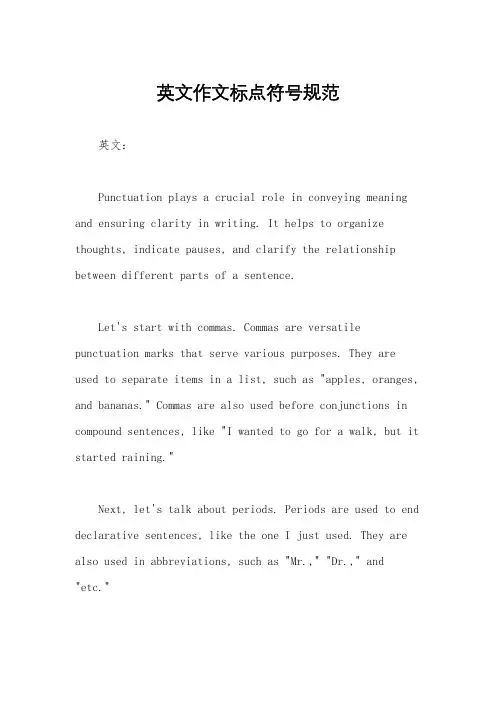
英文作文标点符号规范英文:Punctuation plays a crucial role in conveying meaning and ensuring clarity in writing. It helps to organize thoughts, indicate pauses, and clarify the relationship between different parts of a sentence.Let's start with commas. Commas are versatile punctuation marks that serve various purposes. They are used to separate items in a list, such as "apples, oranges, and bananas." Commas are also used before conjunctions in compound sentences, like "I wanted to go for a walk, but it started raining."Next, let's talk about periods. Periods are used to end declarative sentences, like the one I just used. They are also used in abbreviations, such as "Mr.," "Dr.," and "etc."Another important punctuation mark is the semicolon. Semicolons are used to join two closely related independent clauses without a conjunction, as in "She sings beautifully; her voice is angelic."Quotation marks are used to indicate direct speech orto enclose titles of short works, like articles or short stories. For example, "She said, 'I'll be there at 5 p.m.'" or "I read the article 'The Importance of Punctuation.'"Lastly, let's discuss the exclamation mark and the question mark. Exclamation marks are used to express strong emotions or emphasis, such as "Wow! That's amazing!" Question marks, on the other hand, are used to end direct questions, like "How are you?"Overall, proper punctuation enhances the readabilityand effectiveness of writing by clarifying meaning and guiding the reader through the text.中文:标点符号在书写中起着至关重要的作用,它有助于组织思绪,指示停顿,并澄清句子中不同部分之间的关系。
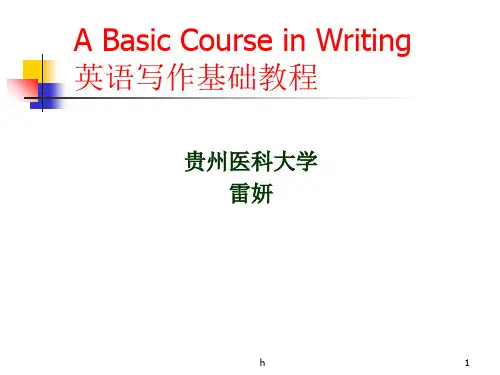
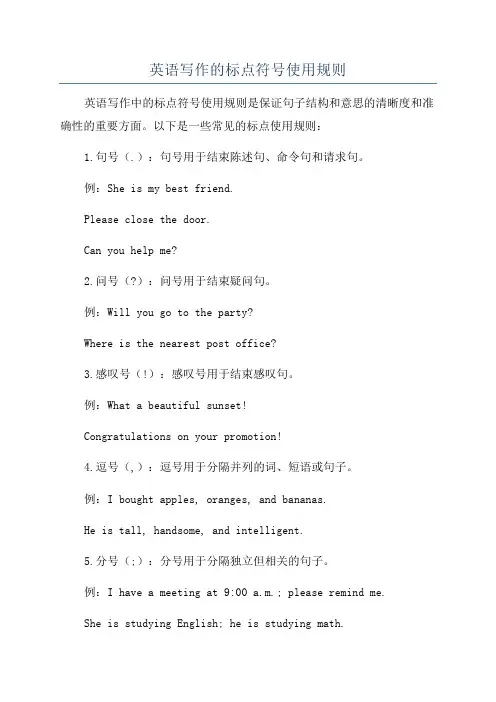
英语写作的标点符号使用规则英语写作中的标点符号使用规则是保证句子结构和意思的清晰度和准确性的重要方面。
以下是一些常见的标点使用规则:1.句号(.):句号用于结束陈述句、命令句和请求句。
例:She is my best friend.Please close the door.Can you help me?2.问号(?):问号用于结束疑问句。
例:Will you go to the party?Where is the nearest post office?3.感叹号(!):感叹号用于结束感叹句。
例:What a beautiful sunset!Congratulations on your promotion!4.逗号(,):逗号用于分隔并列的词、短语或句子。
例:I bought apples, oranges, and bananas.He is tall, handsome, and intelligent.5.分号(;):分号用于分隔独立但相关的句子。
例:I have a meeting at 9:00 a.m.; please remind me.She is studying English; he is studying math.6.冒号(:):冒号用于介绍、引出或解释一个事物或观点。
例:There are four seasons: spring, summer, autumn, and winter.Your essay should include three main points: introduction, body, and conclusion.7.引号(""或''):引号用于引用直接的或间接的语句。
例:He said, "I love you."The famous saying goes, "Actions speak louder than words."8.括号(():括号用于插入附加信息或解释。
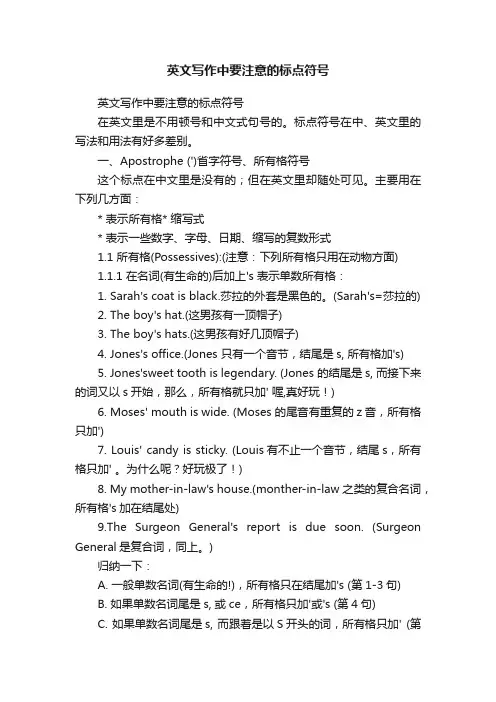
英文写作中要注意的标点符号英文写作中要注意的标点符号在英文里是不用顿号和中文式句号的。
标点符号在中、英文里的写法和用法有好多差别。
一、Apostrophe (')省字符号、所有格符号这个标点在中文里是没有的;但在英文里却随处可见。
主要用在下列几方面:* 表示所有格* 缩写式* 表示一些数字、字母、日期、缩写的复数形式1.1 所有格(Possessives):(注意:下列所有格只用在动物方面)1.1.1 在名词(有生命的)后加上's 表示单数所有格:1. Sarah's coat is black.莎拉的外套是黑色的。
(Sarah's=莎拉的)2. The boy's hat.(这男孩有一顶帽子)3. The boy's hats.(这男孩有好几顶帽子)4. Jones's office.(Jones 只有一个音节,结尾是s, 所有格加's)5. Jones'sweet tooth is legendary. (Jones 的结尾是s, 而接下来的词又以s开始,那么,所有格就只加' 喔,真好玩!)6. Moses' mouth is wide. (Moses 的尾音有重复的z音,所有格只加')7. Louis' candy is sticky. (Louis有不止一个音节,结尾s,所有格只加' 。
为什么呢?好玩极了!)8. My mother-in-law's house.(monther-in-law 之类的复合名词,所有格's加在结尾处)9.The Surgeon General's report is due soon. (Surgeon General是复合词,同上。
)归纳一下:A. 一般单数名词(有生命的!),所有格只在结尾加's (第1-3句)B. 如果单数名词尾是s, 或ce,所有格只加'或's (第4句)C. 如果单数名词尾是s, 而跟着是以S开头的词,所有格只加' (第5句)D. 如果单数名词尾音有重复的s或z音,或是eez音,所有格只加' (第6句)E. 如果B项的名词只有一个音节(syllable),所有格只能加's(第4句)F. 如果B项的名词有二个以上音节,所有格则只加'(第7句)G. 复合词类处理法同A。
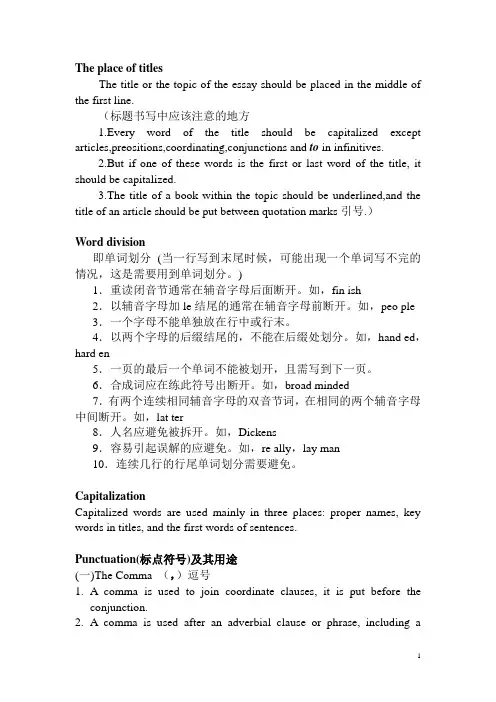
The place of titlesThe title or the topic of the essay should be placed in the middle of the first line.(标题书写中应该注意的地方1.Every word of the title should be capitalized except articles,preositions,coordinating,conjunctions and to in infinitives.2.But if one of these words is the first or last word of the title, it should be capitalized.3.The title of a book within the topic should be underlined,and the title of an article should be put between quotation marks引号.)Word division即单词划分(当一行写到末尾时候,可能出现一个单词写不完的情况,这是需要用到单词划分。
)1.重读闭音节通常在辅音字母后面断开。
如,fin ish2.以辅音字母加le结尾的通常在辅音字母前断开。
如,peo ple 3.一个字母不能单独放在行中或行末。
4.以两个字母的后缀结尾的,不能在后缀处划分。
如,hand ed,hard en5.一页的最后一个单词不能被划开,且需写到下一页。
6.合成词应在练此符号出断开。
如,broad minded7.有两个连续相同辅音字母的双音节词,在相同的两个辅音字母中间断开。
如,lat ter8.人名应避免被拆开。
如,Dickens9.容易引起误解的应避免。
如,re ally,lay man10.连续几行的行尾单词划分需要避免。
CapitalizationCapitalized words are used mainly in three places: proper names, key words in titles, and the first words of sentences.Punctuation(标点符号)及其用途(一)The Comma (,)逗号1.A comma is used to join coordinate clauses, it is put before theconjunction.2.A comma is used after an adverbial clause or phrase, including aprepositional and a participial phrase before the subject, or inserted in the middle of the sentence.mas are used to separate a series of words or phrases with thesame function in the sentence:4.Nonrestrictive clauses and phrases are set off by commasmas set off parenthetical elements6.In dates, a comma is used to separate the day and the year if the orderis month—day—year; no comma need be used if the order is day—month—year.7.With numbers of 1 000 or over, commas or little blank spaces may beused to separate digits by thousands. Form right to left, a commas is placed after every three numerals.(二)The Period (. )句号1.The period is used at the end of a declarative sentence, a mildlyimperative sentence, and an indirect question.2.The period is used with most abbreviations.3.Three spaced period make the ellipsis mark, which indicates theomission of one or more words within a quoted passage.(三)The Semicolon (;)分号1.The semicolon is used between two coordinate clauses which are notlinked by a conjunction.2.Conjunctive adverbs like therefore, however, nonetheless, hence,otherwise, besides, moreover, etc., should not be used as conjunctions to link two coordinate clauses, before them there should be a semicolon, not a comma.3.The semicolon is used with conjunctions when the clauses containinternal punctuation.4.The semicolon is used to separate a series of items with internalcommas.5.A semicolon may be used to join clauses with words omitted, and theomission is sometimes indicated by a comma.(四)The Colon (:)冒号1.The colon is used to introduce a quotation or a statement.2.The colon is used to introduce an examination, a summary, or anappositive.3.The colon is used between the hour and the minute to show the time,to record the scores of games, to end the salutation of a business letter and the introductory remark of a spealer to the chairman and audience.(五)The Question Mark (?)问号1.The question mark is used after a direct question.2.The question mark is used after a statement turned into a question.3.A question mark put between parentheses indicates the writer’suncertainty about the correctness of the preceding word, figure or date.(六)The Exclamation Mark (!)叹号1.The exclamation mark is used after an exclamatory sentence, or anemphatic interjection, or a phrase expressing strong emotion..2.Sometimes the exclamation mark is used after a slogan.(七)Quotation Marks(…)引号1.Double quotation marks are used to enclose direct quotations indialogue or from books or articles.2.Single quotation marks are used to enclose a quotation within aquotation.3.Indirect quotations are not enclosed by quotation marks.4.Quotation marks are used for titles of articles, essays, short stories,short poems, songs, etc., and for headings of chapters or subdivisions of books. Titles of books, newspapers and magazines are generally underlined or italicized.5.Words with special meaning are sometimes put between quotationmarks,(八)Parentheses/Brackets (())圆括号1.Parentheses are used to set off parenthetical, supplementary, orillustrative words.2.Parentheses enclose figures or letters used for enumeration.(九)Square Brackets(【】)方括号1. Square Bracketsare used to indicate corrections or explanations in quoted matter made by the writer who is quoting .2. Square Brackets are used instead of parentheses within parentheses.(十)The Dash (—)破折号1.The dash indicates a break in thought or a change in tone, or aspeaker’s confusion or he sitation.2.The dash indicates an unfinished or interrupted statement.3.A pair of dashes set off a parenthetical element.4.The dash is sometimes used to introduce a summarizing clause after aseries of nouns.5.The dash is sometimes used just like quotation marks in a dialogue.6.The dash may be used to introduce subheadings and authors afterquotations.(十一)The Slash (/ )间隔号1.The slash indicates alternatives, representing the word or or and\or2.The slash is used to separate lines in short quotations of poetry beingquoted in running text.3.When fractions are written in a sentence, a slash is used to separate thenumerator from the denominator.4.Sometimes the slash means “per.”四种句型及其用途Comma逗号——declarative sentence(陈述句):makes an assignment or statementQuestion mark问号——direction question sentence(疑问句):ask a questionExclamation mark叹号——Imperation sentence(祈使句):express a command or a request Exclamatory sentence(感叹句):express a strong feeling or emotionUnderlining and italics1.Titles of books, periodicals, newspaper, plays, movies, operas, andlong poems are underlined or italicized.2.Foreign words are often underlined or italicized.3.Words and letters referred to as such are underlined or italicized.s of ships, aircraft and tragic sinking of the titanic.5.Sometimes underlining or italicizing indicates emphasis.【Words】一、Type of wordsCommon wordsFormal and technical words:(political,legal,scientific,technical,bussiness,literary)Nonstandard words:(slang,jargon,dialectal and obsolete)二、Choice of wordse common or informal words for general purposes; use formal ornonstandard when only on special occasions or for special purposes. e specific and concrete words when giving details; use general orabstract words when making summaries.e idiomatic expressions and words in acceptable collocations; avoidcombinations and that are unidiomatic.4.When there are synonyms, choose the word that expresses themeaning most exactly and that suits the content and style.三、SynonymsThe english language is very rich in synonyms. This is partly due to the fact that english has over the centuries borrowed or absorbed tens of thousands of words from other languages, mainly Greek, Latin and French. Word of anglo-saxon origin are generally colloquial or informal, and they form a great part of the vocabulary that people use daily. Many of the words of greek, latin, and french origin are formal, learned or “big”; and are mainly used in formal writing or speech.四、Some good dictionaries1.Longman dictionary of contemporary english2.Oxford advanced learner’s dictionary of current english.3.Webster’s new word dictionary.4.Collins cobuild english language dictionary.【Sentences】一、Composed sentences 构建句子:①complete structure②begin with a capital letter③full stop, or a question mark, or an exclamation mark④a single complete idea二、Requirement of correct sentences及其对应错误pleteness in structure—fragment in structure2.the right subject—the wrong subject3.agreement between the subject and the predicate verb—disagreement between the subject and the predicate verb 4.agreement between pronoun and antecedent—disagreement between pronoun and antecedent5.clear pronoun reference—unclear pronoun reference6.ending sentences with full stops—ending sentences with no full stops7.joining clauses with conjuctions—joining clauses with no or wrong conjuctions8.a main claus in a complex sentence—no main claus in a complex sentence9.proper use of comparisons—improper use of comparisons10. correct use of the tenses—incorrect use of the tenses四、Quality of effective sentencesEffective sentences have the following quality:Unity(完整性)Coherence(连贯性)Conciseness(简明扼要性)Emphasis(强调)( ways of emphasis:placing, climactic sequence, subordination,the use of verbs in the active voice,balanced sentences平行结构,periodic sentences圆周句,negative/positive sentences,rhetorical question,loose sentences松散句)Variety(表达多样性)五、The difference between subordination and coordinationCoordination is tipically realized by coordinators which join units at the same level while subodination is realized by subordinators which distinguish the superodinate claus and the inferior clause.【Paragraph】一、Ways of developing a paragraphThere are many possible ways to develop a paragraph.(1)development by time(2)development by process(3)development by space(4)development by examples or generalization(5)development by comparison and contrast:(the difference between comparison and contrast :When we compare one thing with another, we show the similarities;when we contrast one thing with another, we show dissimilarities.) (6)development by cause and effect(7)development by classification(8)development by definition(9)development by combination of methods二、The steps of developing a paragraphFirst, think of the topic or theme or main idea,And express it in a complete sentence(topic sentence).Then think of the details or examples or facts that may be used to support or explain the main idea.Work out the outline and arrange them in logical order.三、Features of a paragraphA effective paragraph must have a control idea, and this central idea may be expressed either explicitly in a topic sentence.【Summray】一、Definition (定义)A sumary is the gist or main theme of a piece of a piece of writing expressed in as few words as possible .it should be clear ,brief,and complete,with all the essential points included.二、Uses(用途)①summary writing enables people to get more out of their reading.②summary writing is also a very good exercise to teach us to express thoughts clearly,concisely and effectively.③summary writing has great practical value on grasping quikly and accurately what is read or heard.三、Procedure(步骤)⑴ reading⑵ writing⑶ revision四、Requirements(要求)A.we should be sure of the word limit required .B.we should use our own words to write a summary.C.we should convey the message fully and clearly.D. We should write in the logical order of the original passage.E. Compression (压缩)五、Ways(方法)A. Ommit the details 删除细节B. Reduce the examples 削减例子C. Refuse repeatness 避免重复D. Simplify the decription 简化描述E. Comprise wordy 全面用词F. Generable words 多用泛词e the shortest transitions 最简洁的过渡词H.inderect speech 间接引语【Composition 】一、Steps in writing a composition1.planning a composition( ① putting down all the relevant facts② thinking of a proper theme and deciding on our purpose③ re-examing our list of details and outlining )2.writing the fist draft3.revising the first draft4.making the final copy二、Parts in composition1. the beginning ——introduction(Ways of start a composition :start with …① relevant background material② the time and place of the event to be described③ a quotation④ a question⑤ a statement⑥ a figures or statistics⑦ a definition )2. the middle ——body3.the end ——conclusion三、Types of writing1.narration 记叙体2.exposition 说明文四、Criteria of a good composition (一篇好文章的标准)A good composition have something interesting and/or important,and if possible, something new , to say and that this “something”is expressed clearly, accurately, and appropriately. And we must decide on the purpose and audience of our writing and try to adapt the style and language to suit our purpose and audience.【Outline】一、Types of outline1. sentence outline: made up of sentences2.topic outline:consists of nouns and their modifiers, or their equivalents( =gerund phrases or infinitive phrases )二、Rules for writing outlinesIf we examine closely the two outline above, we may see that they follow these rules:(1)if there is a major point marked “Ⅰ”, there must be at least another marked “Ⅱ”;if there is an “a”, there must be a “b”, and so on.(2)a topic outline is written in noun phrase, and a sentence outline, in sentences. Sentences and phrase are not used together in the same outline. (3)parallel structure are used for the headings of the same rank. Subheads of like rank are of equal importance and are related to the heading and arranged in logical order.(4)the thesis is a complete declarative sentence, usually in the affirmative. It is not a question, a phrase, or a dependent clause, but one sentence which expresses our controlling idea.。
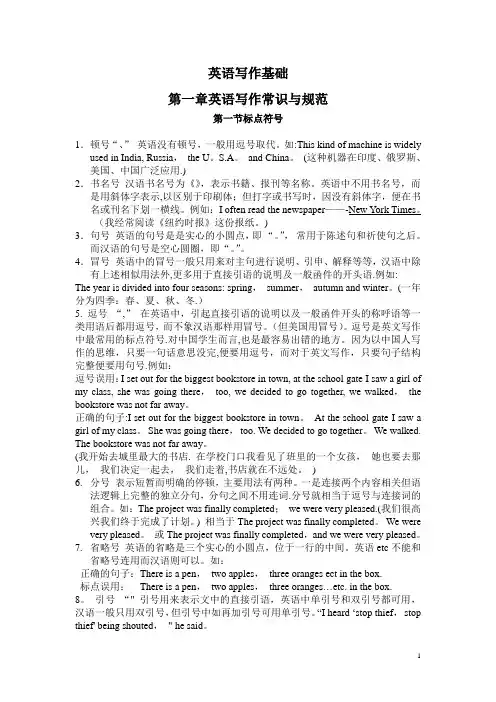
英语写作基础第一章英语写作常识与规范第一节标点符号1.顿号“、”英语没有顿号,一般用逗号取代。
如:This kind of machine is widely used in India, Russia,the U。
S.A。
and China。
(这种机器在印度、俄罗斯、美国、中国广泛应用.)2.书名号汉语书名号为《》,表示书籍、报刊等名称。
英语中不用书名号,而是用斜体字表示,以区别于印刷体;但打字或书写时,因没有斜体字,便在书名或刊名下划一横线。
例如:I often read the newspaper——-New York Times。
(我经常阅读《纽约时报》这份报纸。
)3.句号英语的句号是是实心的小圆点,即“。
”,常用于陈述句和祈使句之后。
而汉语的句号是空心圆圈,即“。
”。
4.冒号英语中的冒号一般只用来对主句进行说明、引申、解释等等,汉语中除有上述相似用法外,更多用于直接引语的说明及一般函件的开头语.例如:The year is divided into four seasons: spring,summer,autumn and winter。
(一年分为四季:春、夏、秋、冬.)5. 逗号“,”在英语中,引起直接引语的说明以及一般函件开头的称呼语等一类用语后都用逗号,而不象汉语那样用冒号。
(但美国用冒号)。
逗号是英文写作中最常用的标点符号.对中国学生而言,也是最容易出错的地方。
因为以中国人写作的思维,只要一句话意思没完,便要用逗号,而对于英文写作,只要句子结构完整便要用句号.例如:逗号误用:I set out for the biggest bookstore in town, at the school gate I saw a girl of my class, she was going there,too, we decided to go together, we walked,the bookstore was not far away。
解忧书店 JieYouBookshop第三章单元测试1单选(2分)Because I love my country. I will never abandon her.A.主语错误B.逻辑错误C.用词错误D.标点错误正确答案:D你选对了2单选(2分)The lost cap found in the box under the bed.A.主语错误B.谓语错误C.修饰语错误D.标点错误正确答案:B你选对了3单选(2分)Next week coming the sports meeting.A.句式结构错误B.主被动错误C.谓语不完整D.缺少主语正确答案:C你选对了4单选(2分)Kate was busy preparing the dinner. When Sally was watching cartoon books.A.主谓一致错误B.主从句位置错误C.标点符号错误D.逻辑关系错误正确答案:C你选对了5单选(2分)Jane rushed out of the classroom, took a taxi to the airport immediately.A.无主句B.流水句C.连动句D.倒装句正确答案:B你选对了第四章单元测试1单选(2分)Joey couldn’t drive to work in his car with a broken leg.A.This sentence is correct with the use of modifier.B.The phrase “in his car” is misplaced.C.The phrase “with a broken leg” is a squinting modifier.D.The sentence should be corrected as “With a broken leg, Joey couldn't drive to work in his car.”正确答案:D你选对了2单选(2分)The waitress served a sandwich to the man that was well buttered.A.This sentence contains a dangling modifier.B.This sentence contains a misplaced modifier, and it should be corrected as “The waitress served a sandwich that was well buttered to the man.”C.This sentence is correct.D.This sentence contains a squinting modifier.正确答案:B你选对了3单选(2分)While eating my dinner, four mosquitoes bit me.A.This sentence contains a dangling modifier, and the correct one should be “While I was eating my diner, four mosquitoes bit me.”。
英文写作中如何使用逗号(Comma)在大部分的写作中,逗号是最常被使用的标点符号。
但因为逗号的使用场景和使用要求最多,因此许多人会对如何正确使用感到困惑,以下是逗号的几点重要功能,以及适当的使用时机。
罗列事物或短语时:▪I bought bread, cheese, and pickles at the grocery store.需要分隔两个独立的较长从句,并使用连接词连接时:▪Astronomers have known about the positions of stars forcenturies, but they didn’t understand that the earth revolves aroundthe sun.在介绍性短句的后面:▪In preparation for the next convention, the representatives studied up on the most important issues.当需要区分附加说明部分的句子(parenthetical phrase),或要分隔插入语(interrupter)时:▪All doctors, if they care about their patients, are concerned with good office hygiene.逗号的常见错误使用案例Comma splice. 不要在未使用连接词的情况下,使用逗号分隔两个独立的从句▪错误范例: Thousands of protesters showed up on the streets, they were shouting and carrying large posters.▪正确范例: Thousands of protesters showed up on the streets;they were shouting and carrying large posters.Combining lengthy phrases. 在复合句中使用逗号或用逗号来分隔短句会造成读者的困惑,这种情况应使用分号。
英语写作中的标点符号用法英语写作中的标点符号用法(一)逗号的用法1. 在并列连词(and, but, for, nor, or, yet )前使用,用来连接句中的各分句。
In fact you do, but you may not remember me. (p17 全日制普通高级中学教科书(必修)英语第一册(下)Senior English for China Student’s Book 1B 以下标有页码未特别注明出处的皆出自本书)2. 用逗号来分隔一系列单词、词组和从句。
In summer, people like to go sailing, swimming, horse-riding and rock-climbing in the mountains. (p42)Red, pink, yellow and white roses filled the huge vases. (牛津现代高级英汉双解词典第6版附录4 标点使用法)In the summer of 1984, many trees died.3. 逗号用来分隔与句子其他部分密切相连的简短插入语或旁白。
(较长的,更为突兀的或复杂的插入成分的则用破折号或圆括号。
)Chemical fertilization,for example, helps to produce better crops, but is harmful to the environment. (p45-46)4. 在并列形容词,即分别修饰同一个名词的形容词之间使用逗号,但也有的形容词之间不加逗号的。
For men, heroism was usually described as bravery and the active, successful overcoming of adversity.5. 用逗号来分隔非限定性修饰语,即该修饰语对于句子的意义并非必不可少。
英语四级作⽂必备知识训练:标点符号的⽤法 在备考英语四级的过程中,各位考⽣不仅要注意词汇的积累,句型的掌握,还要注意标点符号的正确使⽤。
下⾯是店铺整理的英语四级作⽂必备知识训练:标点符号的⽤法,以供⼤家学习参考。
冒号的⽤法 冒号表⽰停顿,其停顿时间⽐分号长⽐句号短。
它可⽤逗号,有时也可⽤句号代替。
尽管现在冒号的使⽤不如50到75年前频繁,但现在它使⽤仍很⽅便,因为它告诉读者其后仍是对上⽂进⼀步的陈述。
冒号还能产⽣轻微的戏剧效果。
冒号常⽤于引出⼀个词、短语、或完整的句⼦(⼦句)来强调,举例解释,或证明刚才所说过的内容。
注意:冒号之后的词可⽤⼤写也可⽤⼩写字母开头。
如果冒号之后的词是另⼀个完整句⼦的开始,则⽤⼤写字母开头。
反之,如果冒号之后的词只是句⼦的⼀部分,则⽤⼩写字母开头。
例 May I offer you a suggestion: don’t drive without your seat belts fastened. The thought continued to perplex him: Where will I go next? ⽤于引出⼀连串⽤来解释或强调已叙述过的内容。
如: In the basement, he kept some equipment for his experiments: the test tubes, some chemical agents, three sun-lamps, and the drill. 冒号后常为缩排且不⽤引号、与全⽂分离的长引⽂。
President Jiang Zemin enjoys quoting the first line of Lincoln’s Gettysburg address: Four score and seven years ago our fathers brought forth on this continent a new nation, conceived in liberty and dedicated to the proposition that all men are created equal. 精典范例 There are only two tragedies in life: one is not getting what one wants, and the other is getting it. --英国作家Oscar Wide 写作时,切忌这样写: The four major reasons for the landslide victory were: the candidate’s personal popularity, the enthusiastic support of his party, his stand on budget issues, and the general mood of the nation. 这样⽤的问题在哪?问题出在冒号⽤于动词were之后,你可能在英语为母语的⼈写的报纸或流⾏刊物中见到这类⽤法,但它在学术写作中不被⼤学教师所接受。
写作文的标点符号的用法英文回答:Punctuation is a crucial aspect of writing that enhances the clarity, accuracy, and flow of your text. It helps readers understand the intended meaning and structure of your writing. Here are the essential punctuation marks used in English writing:1. Period (.):Denotes the end of a complete sentence.Used after abbreviations, initials, and numbers.2. Comma (,):Separates items in a list.Indicates a pause or change in thought.Introduces a dependent clause.3. Semicolon (;):Joins two independent clauses that are closely related.Separates items in a list that contain commas.4. Colon (:):Introduces a list or explanation.Precedes a quotation or dialogue.5. Exclamation point (!):Expresses strong emotion, surprise, or emphasis.Used after interjections.6. Question mark (?):Indicates a question.Used at the end of a sentence.7. Apostrophe (' or 's):Indicates possession.Forms contractions.8. Hyphen (-):Connects words or parts of words.Indicates a range of numbers or dates.9. Quotation marks (" or ''):Encloses direct speech or quotations.Used to indicate irony or sarcasm.10. Brackets ([ or ]):Encloses additional information or explanations.Indicates parenthetical statements.11. Ellipsis (...):Indicates an omission or trailing off of thought.Used to create suspense or emphasis.中文回答:标点符号在文章写作中起着非常重要的作用,它可以提高文章的清晰度、准确性和流畅性。
英文作文标点空格在英文作文中,正确的标点使用和空格放置是非常重要的。
以下是一些关于标点和空格使用的基本规则:1. 句号(.),句号用于句子的结束。
在句号后面,应该跟着一个空格,然后是下一句的第一个字母。
例如,I love writing. It's my passion.2. 逗号(,),逗号用于分隔句子中的项目、列举或者分隔句子的部分。
逗号后应该跟着一个空格,除非逗号后是句号。
例如,I like reading, writing, and painting.3. 分号(;),分号用于连接两个独立但相关的句子。
分号后面应该跟着一个空格。
例如,She studied hard for the exam; however, she didn't pass.4. 冒号(:),冒号用于引出列表、解释或者引用。
在冒号后面应该跟着一个空格。
例如,There are three things I love: reading, writing, and traveling.5. 感叹号(!),感叹号用于表示强烈的感情或者惊讶。
感叹号后面应该跟着一个空格,除非感叹号后是标点符号。
例如,Whata beautiful day it is!6. 问号(?),问号用于表示疑问。
问号后面应该跟着一个空格。
例如,Where are you going?7. 引号(""),引号用于引用别人的话或者表示直接引用的内容。
在引号内外都不需要空格。
例如,"I'll be there soon," he said.8. 括号(()),括号用于插入补充说明或者注释。
括号外应该跟着一个空格。
例如,He went to the store (which was closed) to buy some groceries.9. 破折号(-),破折号用于表示断断续续的思想、插入语或者连接词语。